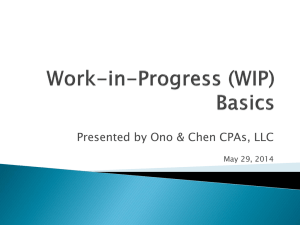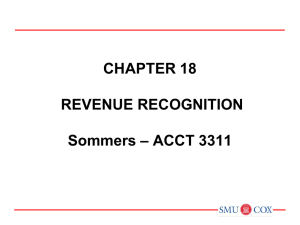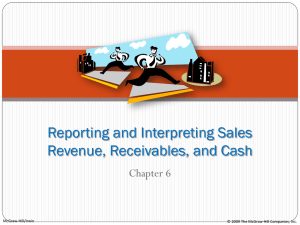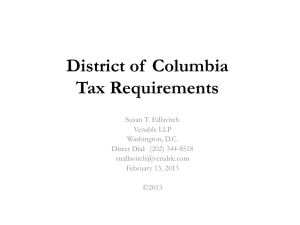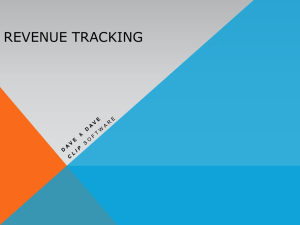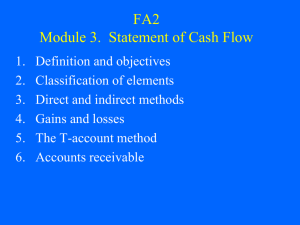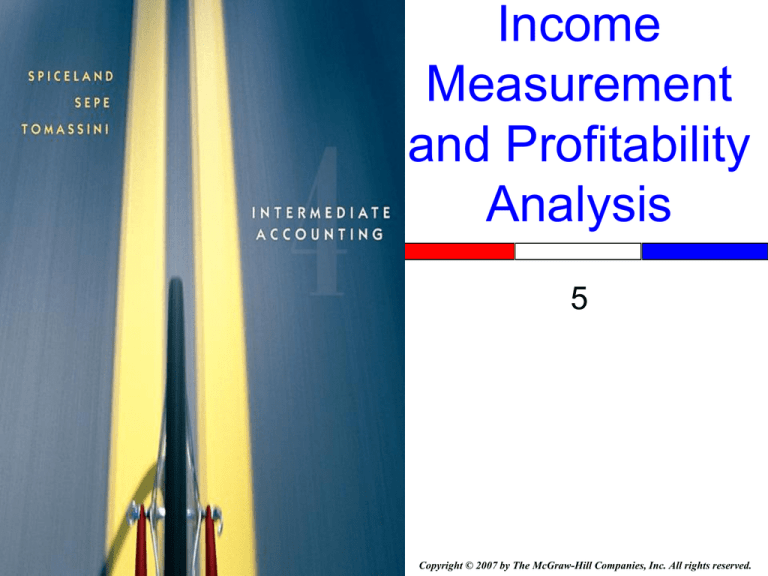
Income
Measurement
and Profitability
Analysis
5
Copyright © 2007 by The McGraw-Hill Companies, Inc. All rights reserved.
5-2
Revenue Recognition
Revenue should be recognized in the
period or periods that the revenuegenerating activities of the company are
performed.
5-3
Realization Principle
Record revenue when:
The earnings
process is
complete or
virtually
complete.
AND
There is
reasonable
certainty as to the
collectibility of the
asset to be
received (usually
cash).
5-4
SEC Staff Accounting Bulletin No. 101
The SEC issued Staff Accounting Bulletin
No. 101 to crackdown on earnings
management. The bulletin provides
additional guidance to determine if the
realization principle is satisfied:
1. Persuasive evidence of an arrangement exists.
2. Delivery has occurred or services have been
performed.
3. The seller’s price to the buyer is fixed or
determinable.
4. Collectibility is reasonably assured.
Completion of the Earnings Process Within
a Single Reporting Period
Recognize Revenue
When the product or
service has been
delivered to the customer
and cash has been
received or a receivable
has been generated that
has reasonable
assurance of
collectibility.
5-5
5-6
Significant Uncertainty of Collectibility
When uncertainties about
collectibility exist, revenue
recognition is delayed.
1. Installment Sales Method
2. Cost Recovery Method
5-7
Installment Sales Method
The installment sales method
recognizes the gross profit by
applying the gross profit
percentage on the sale to the
amount of cash actually collected.
5-8
5-9
Right of Return
In most situations, even though the right
to return merchandise exists, revenues
and expenses can be appropriately
recognized at point of delivery.
Estimate the
returns.
Reduce both
Sales and Cost of
Goods Sold.
Completion of the Earnings Process Over
Multiple Reporting Periods
Completed
Contract Method
Long-term
Contracts
Percentage-ofCompletion
Method
5-10
5-11
Completed Contract Method
Recognizes revenue at a
point in time when the
earnings process is
complete
5-12
Completed Contract Method
Geller Construction entered into a three-year
contract to build a containment vessel for
Southeast Power Company for a contract price of
$1,400,000. Presented below is information
about the contract.
Construction costs incurred during they year
Construction costs incurred in prior years
Cumulative construction costs
Estimated costs to complete at end of year
Total estimated and actual construction costs
2006
$ 250,000
250,000
1,000,000
$ 1,250,000
2007
$ 550,000
250,000
800,000
425,000
$ 1,225,000
2008
$ 400,000
800,000
1,200,000
$ 1,200,000
Billings made during the year
Cash collections during year
$ 250,000
225,000
$ 525,000
470,000
$ 625,000
405,000
Let’s see how Geller will account for
the revenues and cost of this project
using the completed contract method.
5-13
Completed Contract Method
General Journal
Description
Debit
Construction in progress
250,000
Cash, materials, etc.
Accounts receivable
250,000
Billings on construction contract
Cash
Gross
profit is
250,000
not
recognized
250,000
until
225,000
project is
2007
2008
$ 550,000 complete.
$ 400,000
250,000
800,000
Credit
225,000
Accounts receivable
Construction costs incurred during they year
Construction costs incurred in prior years
Cumulative construction costs
Estimated costs to complete at end of year
Total estimated and actual construction costs
2006
$ 250,000
250,000
1,000,000
$ 1,250,000
Billings made during the year
Cash collections during year
$ 250,000
225,000
800,000
425,000
$ 1,225,000
1,200,000
$ 1,200,000
$ 525,000
470,000
$ 625,000
405,000
5-14
Completed Contract Method
General Journal
Description
Debit
Construction in progress
Credit
250,000
Cash, materials, etc.
Accounts receivable
Billings on construction contract
Construction in Progress
- Billings on Construction Contract
Debit Balance (Unbilled Receivable)
Classified as
an asset
250,000
250,000
250,000
Construction in Progress
- Billings on Construction Contract
Credit Balance (Overbilled Receivable)
Classified as
a liability
5-15
Completed Contract Method
General Journal
Description
Debit
Construction in progress
550,000
Cash, materials, etc.
Accounts receivable
550,000
525,000
Billings on construction contract
Cash
Credit
525,000
470,000
Accounts receivable
470,000
Construction costs incurred during they year
Construction costs incurred in prior years
Cumulative construction costs
Estimated costs to complete at end of year
Total estimated and actual construction costs
2006
$ 250,000
250,000
1,000,000
$ 1,250,000
2007
$ 550,000
250,000
800,000
425,000
$ 1,225,000
Billings made during the year
Cash collections during year
$ 250,000
225,000
$ 525,000
470,000
$
Gross
profit is
not
recognized
until
project is
2008
400,000
complete.
800,000
1,200,000
$ 1,200,000
$ 625,000
405,000
5-16
Completed Contract Method
General Journal
Description
Debit
Construction in progress
Credit
400,000
Cash, materials, etc.
Accounts receivable
400,000
625,000
Billings on construction contract
Cash
625,000
405,000
Accounts receivable
405,000
Construction costs incurred during they year
Construction costs incurred in prior years
Cumulative construction costs
Estimated costs to complete at end of year
Total estimated and actual construction costs
2006
$ 250,000
250,000
1,000,000
$ 1,250,000
2007
$ 550,000
250,000
800,000
425,000
$ 1,225,000
2008
$ 400,000
800,000
1,200,000
$ 1,200,000
Billings made during the year
Cash collections during year
$ 250,000
225,000
$ 525,000
470,000
$ 625,000
405,000
5-17
Completed Contract Method
General Journal
Description
Debit
Construction in progress
Cash, materials, etc.
Construction costs incurred during they year
Construction costs incurred in prior years
Accountsconstruction
receivable
Cumulative
costs
Estimated
costson
to complete
at end of
year
Billings
construction
contract
Total estimated and actual construction costs
Cash
Billings made during the year
CashAccounts
collections during
year
receivable
Cost of construction
Construction in progress
Credit
400,000
2006
2007
$
250,000
$
550,000
250,000
625,000
250,000
800,000
1,000,000
425,000
$ 1,250,000
$ 1,225,000
$
405,000
250,000
225,000
$
Cost of construction
Retained earnings
800,000
1,200,000
625,000 $ 1,200,000
$
625,000
405,000
405,000
1,200,000
200,000
Revenue from long-term contract
Revenue from long-term contract
525,000
470,000
2008
400,000
$
400,000
Gross
profit is
recognized
in year 3
since
project is
complete.
1,400,000
1,400,000
1,200,000
200,000
Remember that
the contract price
was $1,400,000.
5-18
Completed Contract Method
Construction in Progress
2006
250,000
2007
550,000
2008
400,000
2008
200,000
1,400,000
Billings on Construction Contract
250,000
2006
525,000
2007
625,000
2008
1,400,000
Entry to transfer title to the customer.
General Journal
Description
Billings on construction contract
Construction in progress
Debit
1,400,000
Credit
1,400,000
5-19
Percentage-of-Completion Method
Measuring Progress Toward Completion
Cost incurred to date
Estimate of project’s total
cost
Gross profit estimate
5-20
Percentage-of-Completion Method
Total costs incurred to date
Percent complete =
Most recent estimate of total
project cost
Let’s look at an
example.
5-21
Percentage-of-Completion Method
Geller Construction entered into a three-year
contract to build a containment vessel for
Southeast Power Company for a contract price of
$1,400,000. Presented below is information
about the contract.
Construction costs incurred during they year
Construction costs incurred in prior years
Cumulative construction costs
Estimated costs to complete at end of year
Total estimated and actual construction costs
2006
$ 250,000
250,000
1,000,000
$ 1,250,000
2007
$ 550,000
250,000
800,000
425,000
$ 1,225,000
2008
$ 400,000
800,000
1,200,000
$ 1,200,000
Billings made during the year
Cash collections during year
$ 250,000
225,000
$ 525,000
470,000
$ 625,000
405,000
Let’s see how Geller will account for the
revenues and cost of this project using the
percentage-of-completion method.
5-22
Percentage-of-Completion Method
Contract price
Actual costs to date
Estimated costs to complete
Total project cost
Total gross profit (Contract price - total costs)
Percentage-of-completion (actual costs to date)
Divided by the estimated total project cost
Equals percentage complete to date
2006
2007
$ 1,400,000 $ 1,400,0
$250,000
$800,0
1,000,000
425,0
$1,250,000
$1,225,0
$
150,000 $
175,0
$
$
250,000 $
1,250,000 $
20.00%
800,0
1,225,0
65.3
Total project gross profit
$
Multiplied by the estimated % of completion
Gross profit earned to date
$
Less gross profit recognized in previous periods
Gross profit recognized currently
$
150,000 $
20.00%
30,000 $
30,000 $
175,0
65.3
114,2
(30,0
84,2
5-23
Percentage-of-Completion Method
General Journal
Description
Debit
Construction in progress
250,000
Cash, materials, etc.
250,000
Accounts receivable
250,000
Billings on construction contract
Cash
250,000
225,000
Accounts receivable
Entries are identical
to the entries for the
completed contract
method.
Contra account to CIP
Credit
225,000
Construction costs incurred during they year
Construction costs incurred in prior years
Cumulative construction costs
Estimated costs to complete at end of year
Total estimated and actual construction costs
2006
$ 250,000
250,000
1,000,000
$ 1,250,000
Billings made during the year
Cash collections during year
$ 250,000
225,000
5-24
Percentage-of-Completion Method
General Journal
Description
Debit
Construction in progress
250,000
Cash, materials, etc.
Accounts receivable
Billings on construction contract
Construction
Cashin Progress
- Billings on Construction
Contract
Accounts receivable
Debit Balance (Unbilled Receivable)
Classified as
an asset
Credit
250,000
250,000
250,000
Construction
225,000 in Progress
- Billings on Construction
Contract
225,000
Credit Balance (Overbilled Receivable)
Classified as
a liability
5-25
Percentage-of-Completion Method
Contract price
Actual costs to date
Estimated costs to complete
Total project cost
Total gross profit (Contract price - total costs)
General Journal
Description
Debit
Construction in progress
Credit
250,000
Percentage-of-completion (actual costs to date)
Cash, materials,
etc.
Divided by
the estimated total project cost
Equals percentage complete to date
Accounts receivable
Total project gross profit
2006
2007
2008
$ 1,400,000 $ 1,400,000 $ 1,400,000
$250,000
$800,000
$1,200,000
1,000,000
425,000
0
$1,250,000
$1,225,000
$1,200,000
$
150,000 $
175,000 $
200,000
$
250,000 $
800,000
$ 1,250,000 $ 250,000
1,225,000
20.00%
65.31%
250,000
$
150,000
by the estimated % of completion
Billings onMultiplied
construction
contract
Cash
Gross profit earned to date
$
Less gross profit recognized in previous periods
Gross profit recognized currently
$
225,000
Accounts receivable
Cost of construction
Construction in progress
Revenue from long-term contract
$
(project is
complete)
175,000 $
20.00%
65.31%
250,000
30,000 $
114,286
(30,000)
30,000 $
84,286 $
225,000
250,000
30,000
280,000
100.00%
200,000
100.00%
200,000
(114,286)
85,714
5-26
Percentage-of-Completion Method
General Journal
Description
Debit
Construction in progress
250,000
Cash, materials, etc.
Accounts receivable
250,000
250,000
Billings on construction contract
Cash
Closing Entry
Accounts receivable
Cost of construction
Construction in progress
250,000
225,000
225,000
250,000
30,000
Revenue from long-term contract
Revenue from long-term contract
Credit
280,000
280,000
Cost of construction
250,000
Retained earnings
30,000
5-27
Percentage-of-Completion Method
Contract price
Actual costs to date
Estimated costs to complete
Total project cost
Total gross profit (Contract price - total costs)
Percentage-of-completion (actual costs to date)
Divided by the estimated total project cost
Equals percentage complete to date
2006
2007
200
$ 1,400,000 $ 1,400,000 $ 1,40
$250,000
$800,000
$1,20
1,000,000
425,000
$1,250,000
$1,225,000
$1,20
$
150,000 $
175,000 $
20
$
250,000 $
800,000
$ 1,250,000 $ 1,225,000
20.00%
65.31%
Total project gross profit
$
Multiplied by the estimated % of completion
Gross profit earned to date
$
Less gross profit recognized in previous periods
Gross profit recognized currently
$
150,000 $
20.00%
30,000 $
30,000 $
(proje
compl
175,000 $
65.31%
114,286
(30,000)
84,286 $
10
20
10
20
(11
8
5-28
Percentage-of-Completion Method
General Journal
Description
Debit
Construction in progress
Credit
550,000
Cash, materials, etc.
550,000
Accounts receivable
525,000
Billings on construction contract
525,000
Cash
470,000
Accounts receivable
Construction costs incurred during they year
Construction costs incurred in prior years
Cumulative construction costs
Estimated costs to complete at end of year
Total estimated and actual construction costs
Billings made during the year
Cash collections during year
470,000
2006
$ 250,000
250,000
1,000,000
$ 1,250,000
2007
$ 550,000
250,000
800,000
425,000
$ 1,225,000
2008
$ 400,000
800,000
1,200,000
$ 1,200,000
$
$
$
250,000
225,000
525,000
470,000
625,000
405,000
5-29
Percentage-of-Completion Method
2006
General
Journal
Contract price
$ 1,400,000
Actual costs to date
$250,000
Description
Debit
Estimated costs to complete
1,000,000
Total project
cost
Construction
in progress
Total gross profit (Contract price - total costs)
2007
2008
$ 1,400,000 $ 1,400,000
$800,000
$1,200,000
425,000
0
$1,250,000
550,000$1,225,000 $1,200,000
$
150,000 $
175,000 $
200,000
Credit
Cash, materials, etc.
Percentage-of-completion (actual costs to date)
Divided
by the estimated total project cost
Accounts
receivable
Equals percentage complete to date
Billings on construction contract
550,000
(project is
$
250,000 $
800,000
$ 1,250,000
$ 1,225,000
525,000
20.00%
65.31%
Total project gross profit
$
Multiplied by the estimated % of completion
Cash Gross profit earned to date
$
Less gross profit recognized in previous periods
Accounts
receivable
Gross profit
recognized currently
$
150,000 $
20.00%
470,000
30,000 $
30,000 $
Cost of construction
550,000
Construction in progress
100.00%
525,000
175,000 $
200,000
65.31%
100.00%
114,286
200,000
(30,000)
(114,286)
84,286 470,000
$
85,714
84,286
Revenue from long-term contract
Revenue from long-term contract
complete)
634,286
634,286
Cost of construction
550,000
Retained earnings
84,286
5-30
Percentage-of-Completion Method
Contract price
Actual costs to date
Estimated costs to complete
Total project cost
Total gross profit (Contract price - total costs)
Percentage-of-completion (actual costs to date)
Divided by the estimated total project cost
Equals percentage complete to date
2006
2007
2008
$ 1,400,000 $ 1,400,000 $ 1,400,000
$250,000
$800,000
$1,200,000
1,000,000
425,000
0
$1,250,000
$1,225,000
$1,200,000
$
150,000 $
175,000 $
200,000
$
250,000 $
800,000
$ 1,250,000 $ 1,225,000
20.00%
65.31%
Total project gross profit
$
Multiplied by the estimated % of completion
Gross profit earned to date
$
Less gross profit recognized in previous periods
Gross profit recognized currently
$
150,000 $
20.00%
30,000 $
30,000 $
(project is
complete)
175,000 $
65.31%
114,286
(30,000)
84,286 $
100.00%
200,000
100.00%
200,000
(114,286)
85,714
5-31
Percentage-of-Completion Method
General Journal
Description
Debit
Construction in progress
400,000
Cash, materials, etc.
Accounts receivable
400,000
625,000
Billings on construction contract
Cash
625,000
405,000
Accounts receivable
Cost of construction
Construction costs incurred during they year
Construction in progress
Construction costs incurred in prior years
Revenue from
long-term contract
Cumulative construction
costs
Estimated costs to complete at end of year
Revenue
long-term
contract
Total estimated
andfrom
actual
construction
costs
Cost of construction
Billings madeRetained
during the
year
earnings
Cash collections during year
Credit
405,000
2006
400,000
$ 250,000
85,660
250,000
1,000,000
485,660
$ 1,250,000
2007
2008
$ 550,000
$ 400,000
250,000
800,000
485,660
800,000
1,200,000
425,000
$ 1,225,000
$ 1,200,000
$ 250,000
225,000
400,000
$ 525,000
85,660 $ 625,000
470,000
405,000
5-32
Percentage-of-Completion Method
2006
2007
2008
General Journal
Contract price
$ 1,400,000 $ 1,400,000 $ 1,400,000
Actual costs to date
$250,000
$800,000
$1,200,000
Description
Debit
Credit
Estimated costs to complete
1,000,000
425,000
0
Total project cost
Construction
in progress
Total gross profit (Contract price - total costs)
$1,250,000
$1,225,000
$1,200,000
400,000
$
150,000 $
175,000 $
200,000
Cash, materials, etc.
Percentage-of-completion (actual costs to date)
Divided by the
estimated total project cost
Accounts
receivable
Equals percentage complete to date
Billings on construction contract
$
250,000 $
800,000
$ 1,250,000625,000
$ 1,225,000
20.00%
65.31%
Total project gross profit
$
Multiplied by the estimated % of completion
Cash
Gross profit earned to date
$
Less gross profit recognized in previous periods
Accounts
receivable
Gross
profit recognized
currently
$
Cost of construction
Construction in progress
150,000 $
175,000 $
20.00%
65.31%
30,000405,000
$
114,286
(30,000)
30,000 $
84,286 $
100.00%
625,000
200,000
100.00%
200,000
(114,286)
405,000
85,714
400,000
85,714
Revenue from long-term contract
Revenue from long-term contract
400,000
(project
is
complete)
485,714
485,714
Cost of construction
400,000
Retained earnings
85,714
5-33
Percentage-of-Completion Method
Construction in Progress
2006
250,000
30,000
2007
550,000
84,286
2008
400,000
85,714
1,400,000
Billings on Construction Contract
250,000
2006
525,000
2007
625,000
2008
1,400,000
Entry to transfer title to the customer.
General Journal
Description
Billings on construction contract
Construction in progress
Debit
1,400,000
Credit
1,400,000
5-34
Long-term Contract Losses
Periodic Loss for
Profitable
Projects
Determine periodic
loss and record loss
as a credit to the
Construction in
Progress account.
Loss Projected
for Entire Project
Estimated loss is
fully recognized in
the first period the
loss is anticipated
and is recorded by a
credit to
Construction in
Progress account.
5-35
Software Revenue Recognition
Statement of Position 97-2
If a sale includes multiple elements (software,
future upgrades, postcontract customer
support, etc.), the revenue should be allocated
to the various elements based on the relative
fair value of the individual elements.
This will likely result in a portion of the
proceeds received from the sale of software
being deferred and recognized as revenue in
future periods.
5-36
Franchise Sales
Initial Franchise
Fees
Continuing
Franchise Fees
Generally are
recognized at a
point in time when
the earnings
process is virtually
complete.
Recognized over
time as the services
are performed.
Source: SFAS 45
5-37
Receivables Turnover Ratio
Receivables
Turnover =
Ratio
Net Sales
Average Accounts Receivable
Whenever a ratio divides an income statement
balance by a balance sheet balance, the average
for the year is used in the denominator.
This ratio measures how many
times a company converts its
receivables into cash each year.
5-38
Average Collection Period
Average
Collection
Period
=
365
Receivables Turnover Ratio
This ratio is an approximation of the
number of days the average accounts
receivable balance is outstanding.
5-39
Inventory Turnover Ratio
Inventory
Turnover
Ratio
=
Cost of Goods Sold
Average Inventory
This ratio measures the number
of times merchandise inventory
is sold and replaced during the year.
5-40
Average Days in Inventory
Average
365
=
Days in
Inventory Turnover Ratio
Inventory
This ratio indicates the number
of days it normally takes to sell inventory.
5-41
Asset Turnover Ratio
Asset
Turnover
Ratio
=
Net Sales
Average Total Assets
This ratio measures how efficiently a
company utilizes all of its assets to
generate revenue.
5-42
Profit Margin on Sales
Profit Margin
=
on Sales
Net Income
Net Sales
This ratio indicates the portion of
each dollar of revenue that is
available to cover expenses.
5-43
Return on Total Assets
Return on
=
Total Assets
Net Income
Average Total Assets
This ratio measures how well assets
have been employed.
5-44
Return on Equity
Return on
Equity
=
Net Income
Average Shareholders’ Equity
This ratio measures the ability of
management to generate net income from
the resources the owners provide.
5-45
Interim
Reporting
Appendix 5
5-46
Interim Reporting
Issued for periods of less than
a year, typically as quarterly
financial statements.
Serves to enhance the
timeliness of financial
information.
Fundamental debate centers
on the choice between the
discrete and integral part
approaches.
5-47
Interim Reporting
Reporting Revenues
and Expenses
With only a few exceptions, the
same accounting principles
applicable to annual reporting are
used for interim reporting.
Reporting Unusual
Items
Discontinued operations and
extraordinary items are reported
entirely within the interim period in
which they occur.
Earnings Per Share
Quarterly EPS calculations follow
the same procedures as annual
calculations.
Reporting Accounting
Changes
Accounting changes made in an
interim period are reported by
retrospectively applying the changes
to prior financial statements.
5-48
Minimum Disclosures
Sales, income taxes,
and net income
Discontinued operations,
extraordinary items, and
unusual or infrequent
items
Earnings per share
Contingencies
Seasonal revenues,
costs, and expenses
Changes in
accounting principles
or estimates
Significant changes
in estimates for
income taxes
Significant changes
in financial position
5-49
End of Chapter 5


